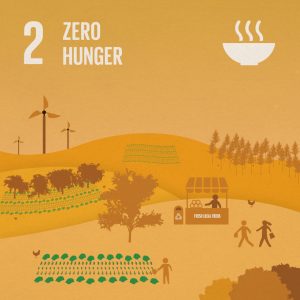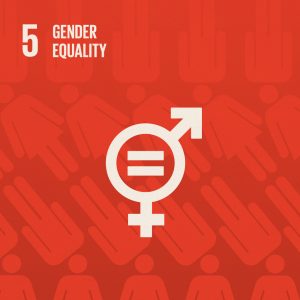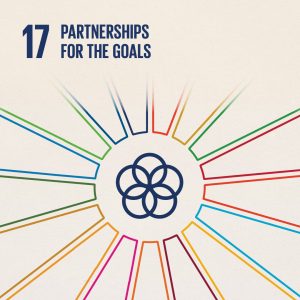As the coronavirus pandemic began its relentless march around the world, a global hunger crisis swiftly erupted in its wake. And with it, the second Sustainable Development Goal – Zero Hunger – has become more imperiled.
Instead of diminishing, the number of the world’s hungry has risen dramatically during the pandemic. The global economic slowdown, the mounting job losses, the shattered food supply chains, and the shuttered schools have the United Nations’ World Food Program warning that an additional 260 million people globally are at risk of severe hunger, and that malnourished children could die at the rate of 10,000 a month. In the United States, we have seen the desperate surge at food banks and food pantries, the traffic jams at drive-through bread lines, and the scramble to nourish children no longer receiving breakfast and lunch programs once the schools closed.
All of this has made the work of Auburn’s Hunger Solutions Institute (HSI) more important and urgent than ever. The HSI, in the College of Human Sciences, forges collective action at the campus, community, state and global levels to share knowledge and best practices in the fight to end hunger. In these efforts to create multi-sector coalitions, HSI is a key ally in successfully achieving SDG2.
With more than one in five children in Alabama experiencing food insecurity – living in households struggling to access or afford sufficient nutritional food for adequate daily sustenance – the HSI leads an End Child Hunger in Alabama initiative supported by a task force of more than 30 key state leaders and activists from government, nonprofit and faith-based communities, education groups, and the private sector, headed by the governor. The HSI also provides leadership for Universities Fighting World Hunger, a grassroots student movement of more than 300 university affiliates around the world aiming to raise awareness of hunger wherever it may be and inspire the next generation of activists. HSI is also the coordinator of Presidents United to Solve Hunger (PUSH), a consortium of more than 100 higher education institutions committed to ending hunger and malnutrition, including promoting academic research and curriculum, like Auburn’s Hunger Studies minor.
The Hunger Solutions Institute is also pioneering research into campus hunger. It leads the Alabama Campus Coalition for Basic Needs, a gathering of 10 universities in the state, and is developing a campus food aid self-assessment tool so schools can better measure and implement programs to meet the needs of their food-insecure students. In recent months, responding to the hunger triggered by the pandemic, HSI researchers hurried to compile a comprehensive food resource guide, mapping government and charitable assistance – food banks, pantries, school feeding sites, senior meals programs, stores accepting SNAP food stamps and Women and Infant Children supplemental nutrition coupons – available throughout Alabama, county by county.
At the core of HSI’s work are the beliefs that hunger is a solvable problem, particularly when the knowledge and passion from all academic disciplines are combined, and that every individual has something to contribute to conquering hunger, no matter your academic major, skill set, or career path. This isn’t just a task for the agriculture, nutrition, medical and health disciplines, but also for business, engineering, architecture, education, liberal arts, law, the sciences, sociology, communications, computer technology, math, fashion, design, religion, ethics — anything you may be studying. Yes, even journalism.
After 30 years as a reporter and foreign correspondent for The Wall Street Journal and a decade writing books about how hunger and malnutrition abide in the 21st century, I arrived at Auburn this semester to raise the clamor with the Hunger Solutions Institute. That’s what I can do as a journalist – spread the word, outrage and, I hope, inspire.
My personal moment of great disruption came in May 2003 in Ethiopia, during the first great hunger crisis of our new millennium. More than 14 million people were on the doorstep of starvation. On my first day in the capital of Addis Ababa, I was surveying the scope of the famine with the World Food Program. One of the WFP officials offered me a piece of advice: “Looking into the eyes of someone dying of hunger becomes a disease of the soul,” he told me. “You see that nobody should have to die of hunger.”
The next day, we were in an emergency feeding camp; we parted the flaps of one of the large relief tents and stepped inside to a scene of utter horror. Dozens of children were starving to death in the arms of their parents. Speechless, I wandered to the back of the tent and spoke with a father cradling his young son.
“What have I done to my child?,” asked the father, a poor smallholder farmer whose crops had failed in the drought. It was a profound question, but a more troubling one needed to be raised: What had we done to his child, allowing such medieval suffering when the world as a whole was producing more food than ever before?
What I saw, and heard, did indeed become a disease of my soul. In the normal routine of a foreign correspondent, I would have written the story and moved on to the next place, the next adventure. But this was the one story that stopped me cold: hunger in the 21st century. It became the sole focus of my journalism, eventually leading me away from The Wall Street Journal to writing books and using whatever platform was available to raise the clamor.
And now my diseased soul has brought me to Auburn, to the Hunger Solutions Institute, to join the next generation of activists leading the way, finally, to Zero Hunger.
Post contributed by Roger Thurow, Scholar-in-Residence at the Hunger Solutions Institute, College of Human Sciences. He is also a Senior Fellow of the Global Food and Agriculture Program at The Chicago Council on Global Affairs.
Learn about the SDGs & AU and our contributions related to this post.







